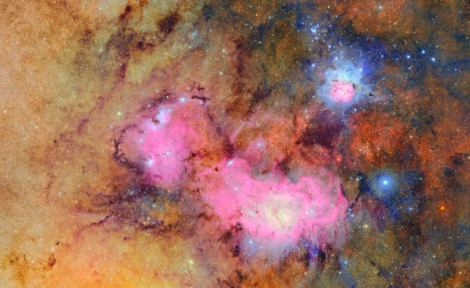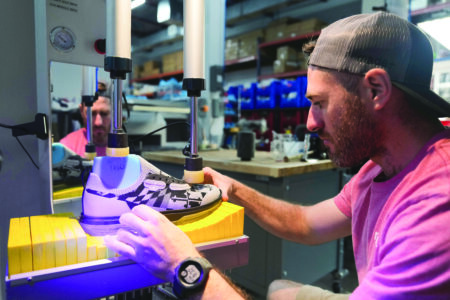Virtual programs keep library in touch with young readers

Ashley Weyer, left, and Lois Rhodes, the driving force behind the “Story Time with Mrs. Ashley” programs put out by Abbeville County Library, pose Dec. 29 in Abbeville, S.C. (AP photo)
ABBEVILLE, S.C. — If you film it, they will come.
That’s what Lois Rhodes and Ashley Weyer with Abbeville County Library hope to accomplish with “Story Time with Mrs. Ashley” programming.
Impetus for the show arose from the COVID-19 pandemic, which closed the library for 10 weeks from March to May. Even after the library reopened, people weren’t visiting like they used to and almost no one lingered. The library also had to close the children’s play area.
Story times are nothing new. The library has been conducting in-house events for years. Library staff had to figure out how to reach out to children. Thus, the virtual story time shows were born.
They had to look into virtual programming, especially with the summer reading program coming up, Rhodes said.
There was just one problem, according to Weyer and Rhodes: They had no experience working on video programming.
“It’s been a big learning experience,” Rhodes said.
“This is uncharted territory,” Weyer added. “No one here had any background in the field.”
The library bought equipment, and Rhodes taught herself how to use it. Along the way, Rhodes taught herself how to edit video, which is a handy skill. At first, Rhodes and Weyer tried to film programs in one long take. They learned filming short clips and putting them together is easier. Filming the shows in segments can feel choppy, Weyer said. The goal is to make sure the cuts flow.
By June, “Story Time with Miss Ashley” started airing on the library’s Facebook page on Facebook Live. Programs, which air at 11 a.m. on Mondays, are aimed at children from preschool age to second grade, they said.
Weyer said she used to teach kindergarten, so she called on that experience to read.
“It’s very different talking to a roomful of children than talking to a camera,” she said. “Once you get used to it, it’s the same. When you make a mistake, you can refilm or go on.”
When they first started filming programs, Rhodes would put a teddy bear next to the camera so Weyer would have someone to read to.
Determining how long programs should be was another lesson. Initially, Rhodes and Weyer figured a 20-minute format would be good. They learned that young children’s attention tended to waver after about 10 minutes. Thereafter, programs are produced to last roughly 10 minutes.
“Storytime with Miss Ashley” videos stay up on the library’s Facebook page, so people can watch them when it is convenient. Nearly six months or programs are archived.
Rhodes and Weyer film four programs in a day and take the rest of the month to edit films into 10-minute long programs. That’s the ideal. Rhodes said they have had to work in a rush, filming a program on a Tuesday, then editing it to have to ready for release on Wednesday.
That kind of rush job is something they try to avoid.
“It (producing programs) sounds like it’s super simple, but it isn’t,” Rhodes said. “We both tend to be perfectionists. We try to present quality programs … we want to do it well.”
They have reshot segments because the frame of the backdrop showed. “It’s something children wouldn’t notice, but we would notice,” she said.
Another lesson was realizing they have to get permission from publishers to use books in the programs. Weyer said it was a big change because with in-person classes, you can pull any book from the shelf.
At first, the programs only got a few views, Rhodes said. After promoting the shows, the programs averaged about 50 views a week. A look at the video archive reveals some shows have gotten more than 150 views.
Rhodes said her grandson enjoys the story time programs. She said she uses him as a one-person focus group.
People are watching. Rhodes and Weyer said they have gotten input from educators in Calhoun Falls, guest readers and presenters from the community and participation from students with the Due West Robotics teams.
Members of the Due West Robotics’ seventh-grade team, the Nacho Average Doritoes, did a program in November, Weyer said. That experience helped lead to the STEAM Factory project, which has been developed with the “Due Westerners,” the high school team.
Programs, which are aimed for children in third through seventh grades, will focus on science, technology, engineering, arts and math. Robotics team members will present 2 1/2-minute long programs. Rhodes said each week, students will present a program on each topic, explaining the hows and whys of each subject.
Three months of STEAM Factory programs have been filmed. More programs will be filmed with students, with the goal of having programs last up to the summer reading program, Rhodes said, adding that some students even expressed an interest in learning how to edit video.
STEAM Factory shows help the library and the students are doing community outreach, she said. Programs start airing at 11 a.m. Friday and on subsequent Fridays.
Another program that will be presented at 11 a.m. Wednesdays is “Read, Eat and Grow.” It focuses on health literacy and nutritional education and was made possible by a grant from the South Carolina State Library System. The grant included a “kitchen in a box,” which included a burner, an oven, a blender, pots and pans, utensils — pretty much everything but the kitchen sink.
Weyer and Rhodes earned certification in food handling for the programs. Anybody can benefit from watching the programs, Weyer said. Programming features easy skillet recipes, simple smoothies and presenting easy workouts to do at home.
“There’s nothing in it that a teenager wouldn’t benefit from. If I can teach a teenager about a sweet treat that doesn’t have sugar in it, I’ll be happy,” Weyer said, adding that she and Rhodes have thought about getting a dentist to appear on the show.
Rhodes said other segments in the programming include a “Get Up and Move” program, “Science Fun,” “Songs and Rhymes” and “Craft Time.”
Ambitions for programming include book reviews and using a green screen, similar to a screen used in skits from the TV show “Whose Line Is it Anyway” where videos are shown in the background with a presenter in front.
There are no limits when using a green screen, Weyer said. She can read a book on China and can put up an image of the Great Wall of China.
Weyer noted that she will have to be careful what colors she wears in front of the green screen. Depending on colors being projected onto the screen, she and Rhodes joked about a program featuring the floating head of Miss Ashley. They said they don’t want to terrify their viewers.
Even when COVID-19 is an unpleasant, distant memory, virtual programming will continue. Weyer said programming will be a constant; it is not going away. Now the library will have the opportunity for in-person and video.
“When we started editing, it was really stressful,” Rhodes said. “Now it’s fun. It’s allowed us to be creative in how we reach our patrons.”
That creativity extends to the set for Story Time. It’s not the big production viewers might think. Shows are filmed with a small camera in a small conference room at the library, with a backdrop for Weyer to read in front of.





